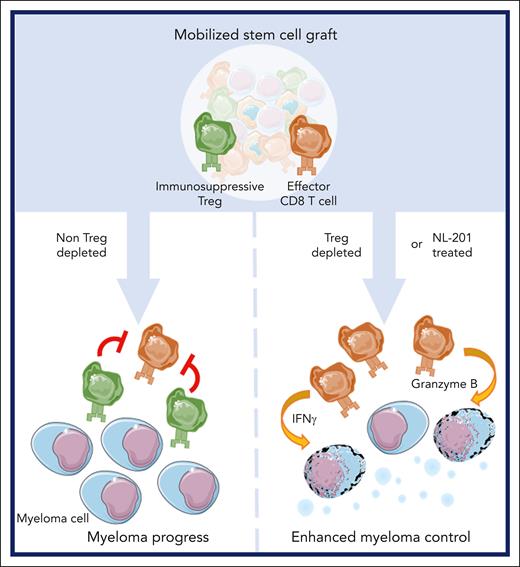In this issue of Blood, Takahashi et al1 reveal that during stem cell mobilization (SCM), T cells originating from the bone marrow migrate to the blood and exhibit a preference for returning to the marrow after adoptive transfer. Additionally, the study demonstrates that depleting regulatory T cells (Tregs) during SCM results in the expansion of polyfunctional effector T cells within mobilized grafts, ultimately enhancing antimyeloma immunity following autologous stem cell transplantation (ASCT) in a preclinical model (see figure).
Mobilized stem cell grafts from patients with myeloma contain a high number of both immunosuppressive Tregs and effector CD8 T cells. These Tregs limit the tumoricidal effect during autologous stem cell transplantation. However, depletion of Tregs or activation of CD8 with an interleukin 2 (IL-2)/IL-15 agonist (NL-201) leads to expanded polyfunctional CD8 T cells, which ultimately improves antimyeloma immunity after autologous stem cell transplantation. IFN, interferon.
Mobilized stem cell grafts from patients with myeloma contain a high number of both immunosuppressive Tregs and effector CD8 T cells. These Tregs limit the tumoricidal effect during autologous stem cell transplantation. However, depletion of Tregs or activation of CD8 with an interleukin 2 (IL-2)/IL-15 agonist (NL-201) leads to expanded polyfunctional CD8 T cells, which ultimately improves antimyeloma immunity after autologous stem cell transplantation. IFN, interferon.
For the >3 decades since its inception, ASCT remains the gold standard for the treatment of young patients with multiple myeloma (MM). Even the advent of groundbreaking agents, such as immunomodulatory drugs (IMiDs), proteasome inhibitors, and monoclonal antibodies, has not supplanted ASCT, but rather underscored its pivotal role in standard care.2 The therapeutic success of myeloablative chemotherapy and ASCT was long assumed to be predicated on cytoreduction. However, there is now clear evidence that establishment of antimyeloma immunity is a key factor for the therapeutic success of ASCT. Along those lines, Geoffrey Hill's working group has developed a preclinical model demonstrating that the therapeutic benefit of ASCT lies with the generation of antigen-specific CD8 T cells that are able to control myeloma progression.3 Despite these advances in our understanding and the clinical application of ASCT, a significant proportion of patients inevitably experience disease progression following treatment. This is intricately linked to the emergence of immune escape features of MM cells, underscoring the critical need for novel strategies to fortify antimyeloma immunity and address the limitations associated with disease relapse after ASCT.
In the present study, Takahashi et al explored factors influencing antimyeloma immunity during ASCT. To elucidate this topic, the authors analyzed the T-cell composition of bone marrow (BM) and peripheral blood stem cells (PBSCs) from patients with myeloma. Interestingly, mobilized stem cell grafts included a high number of effector CD8 T cells compared with the BM, while also containing a significant amount of immunosuppressive Tregs. The authors determined that these cells were mobilized from the BM into the peripheral blood during SCM. This is particularly relevant as the myeloma-experienced CD8 T cells from the donor transplant are crucial for tumor-specific immunity after ASCT.
However, their data indicated that unique immunosuppressive BM Tregs are also mobilized into PBSC grafts, which would reduce the beneficial effect of CD8 T cells.4 Accordingly, the genetic depletion of Tregs during SCM resulted in a higher frequency of polyfunctional CD8 T cells in the graft and led to tumor-specific long-term control of myeloma after ASCT. Conversely, antibody-mediated depletion led to a reduction in the number of Tregs, but not to an increase in CD8 T cells, consistent with a pilot study following anti-CD25 (basiliximab) treatment.5 Interestingly, the authors discovered a new strategy and used a synthetic interleukin 2 (IL-2)/IL-15 receptor agonist (NL-201) to expand the polyfunctional CD8 T cells in the mobilized graft (without triggering Tregs), which led to protection against myeloma progression in recipients of ASCT in an animal model.
Two particular aspects of this study should be emphasized. First, the study adds further support to the hypothesis that long-term tumor control can be mediated by antigen-specific T cells in myeloma. This leads to the interesting research avenue of characterizing these T cells more closely, particularly focusing on the clonality and the targeted antigen landscape. This information may have high translational value, as there could be myeloma-specific neoantigens or defined antigens that are not engaged due to Treg suppression. The murine Vk∗MYC model used by the authors displays a high mutation load and chromothripsis,6 as in humans, which supports the development of neoantigens and neoantigen-specific T-cell activation in myeloma.7 The identification of such antigens or associated T-cell receptors may hold the key for a therapeutic intervention to better control myeloma with antigen-based immunotherapy.
Second, the study strongly suggests that selective enhancement of antimyeloma activity during ASCT by the novel and elegant use of the IL-2/IL-15 receptor agonist can be therapeutically beneficial. A key feature of NL-201 is its selective binding to the IL-2 receptor βγc heterodimer, while avoiding interaction with the IL-2 α subunit, which, in turn, leads to the expansion of cytotoxic T cells but not Tregs.8 Importantly, the agonist is currently in a phase 1 clinical trial in patients with relapsed or refractory cancer (NCT04659629). As the recent incorporation of proteasome inhibitors, monoclonal antibodies, and IMiDs into each treatment phase has significantly improved the efficacy of ASCT,9 these promising data provide a good starting point to use NL-201 in combination with these regimens in ASCT.
Conflict-of-interest disclosure: The author declares no competing financial interests.


This feature is available to Subscribers Only
Sign In or Create an Account Close Modal